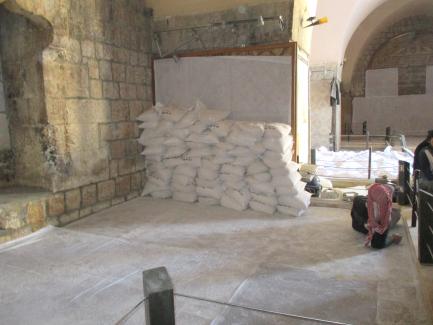Syrian volunteers worked to repair and fortify damage to the roof of the Ma’arra Museum to prevent further deterioration and possible collapse. (Photo courtesy Penn Cultural Heritage Center at the University of Pennsylvania Museum of Archaeology and Anthropology)
Emergency Preservation Activities Completed at Syria’s Ma’arra Mosaic Museum
Syria’s renowned Ma’arra Mosaic Museum, significantly damaged and in danger of collapse as a result of the country’s long and ongoing civil war, has undergone emergency conservation and protection efforts by Syrian cultural heritage professionals and volunteers.
The emergency project, first conceived during a Syrian cultural heritage emergency workshop in the summer of 2014, was a months-long initiative of an international group of organizations, known as the Safeguarding the Heritage of Syria and Iraq Project, which is a consortium of the Penn Cultural Heritage Center at the University of Pennsylvania Museum; the Office of the Under Secretary for History, Art, and Culture at the Smithsonian; the Geospatial Technologies Project at the American Association for the Advancement of Science; Shawnee State University; The Day After; and the U.S. Institute of Peace. The consortium planned the project, coordinated necessary governmental approvals in the war-torn country and paid for the materials required to carry out the work with support from the J.M. Kaplan Fund.
“The Ma’arra Museum stabilization project demonstrates the commitment of our Syrian colleagues to saving their heritage, even in the face of armed conflict,” said Corine Wegener, the Smithsonian’s cultural heritage preservation officer. “I’m very proud that the Smithsonian could support their efforts, and we look forward to future collaborations with them, as well as with other colleagues around the world working to save heritage in crisis.”
Housing one of the most important collections of third-to-sixth century Roman and Byzantine mosaics in the Middle East, the Ma’arra Mosaic Museum is located about 50 miles south of Aleppo. The museum was an old caravanseri, or roadside inn, that was constructed in 1595 and refurbished as a museum in 1987.
The emergency protection project aimed to secure the mosaics from further harm during the conflict. After consultation with experts in mosaic conservation, the Syrian team applied a layer of glue and cloth designed to fortify and keep the tesserae (individual tiles in a mosaic) together. Several truckloads of sandbags were then laid out to protect the mosaics from further damage. Altogether, some 1,600 square feet of mosaics were protected. Holes in the roof were also repaired to prevent further deterioration and possible collapse.
“We’ve seen how the invaluable cultural heritage of Syria has fallen prey to destruction by heavy artillery, targeted explosive attacks and looting as never before,” said Syrian archaeologist Salam Al-Kuntar, a visiting research scholar at the Institute for the Study of the Ancient World at New York University and a consulting scholar at the Penn Cultural Heritage Center. “We all know that what a group of dedicated Syrians has done is a small but meaningful act and a courageous act, taking difficult steps during wartime to preserve Syrian history for future generations. Let us hope that this will be the first of many more concrete efforts of preservation.”
“The importance of this cultural heritage is nowhere more demonstrable than when it comes to the issue of national identity and what makes a Syrian a Syrian,” said Amr Al-Azm, a professor at Shawnee State University. “Once the current violence ends, the people of Syria will need to find ways to reconnect with the symbols that once united them across religious and political lines. The country’s ancient past as represented in this rich cultural heritage will be key to this process. Protecting and preserving Syria’s history and heritage therefore is about safeguarding its future, too.”
# # #
SI-93-2015







